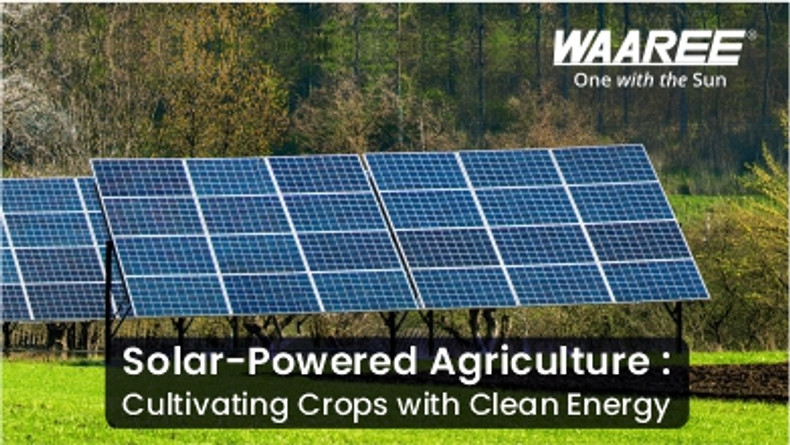Agriculture is the backbone of civilization, providing sustenance for communities around the globe. However, conventional agriculture often comes at a high environmental cost through fertilizer runoff, habitat destruction from land clearing, and significant greenhouse gas emissions from farm equipment. As the effects of climate change threaten food security worldwide, the agriculture sector urgently needs more sustainable practices. One innovative solution is solar-powered agriculture, which integrates solar panel infrastructure directly into crop fields and livestock farms. Often called agrivoltaics, these integrated systems allow agriculture and renewable energy production to exist harmoniously while providing multiple economic and environmental benefits.
Benefits of Agrivoltaic Systems:
Greater Efficiency and Crop Yields
Several research studies have conclusively shown that crops grow well under and around solar panels. The partial shade and shelter provided by the panels help reduce water evaporation from the soil while blocking harsh winds. This means the crops use less irrigation water and are protected from weather damage, boosting yields over time. For example, a Massachusetts farm using agrivoltaics reported a 160% increase in crop revenues compared to conventional agriculture. Studies in Arizona and Japan also found significantly higher chili pepper and lettuce yields under solar panels compared to control plots.
Increased Farm Revenue
Installing a solar system on agricultural land provides farmers and ranchers with a major new revenue stream by selling electricity back to the grid. These additional earnings provide financial resilience, insulating agricultural producers from volatile crop prices and unpredictable weather. Several US states even legally define such “dual-use” agrivoltaic systems as agricultural land instead of commercial solar installations, enabling producers to continue receiving valuable tax breaks. With the falling prices of solar panels combined with increased crop yields, adopting agrivoltaic is now an extremely attractive economic proposition for farmers.
Lower Environmental Impact
In addition to boosting efficiency, solar-powered agriculture substantially lowers environmental impacts compared to conventional practices. Integrating solar infrastructure minimizes new land clearing since panels are installed over existing crop fields and pastures instead of occupying primary forest or wetlands. This preserves valuable ecological habitats and natural carbon sinks that would otherwise be destroyed. The clean solar power generated also offsets considerable fossil fuel emissions from tractors, harvesters, and other machinery that make agriculture one of the most significant global emitters of greenhouse gases. Limiting these emissions and land use changes is crucial for mitigating climate change threats that jeopardize future food production capacity worldwide.
Finally, agrivoltaics reduces agricultural pollution by enabling a significant reduction in synthetic fertilizers and pesticides. These chemicals have contaminated drinking water supplies and fisheries around the world, creating aquatic “dead zones” devoid of oxygen. With higher crop yields and more efficient water usage, farmers need fewer chemical inputs for solar panel infrastructure.
Realizing the Potential of Solar-Powered Agriculture
While agrivoltaics provides immense economic, social, and environmental benefits, widespread adoption faces regulatory and technical barriers in many regions. Outdated zoning laws often prohibit the construction of solar infrastructure on designated agricultural lands, stymieing hybrid systems. Fortunately, policymakers in several cutting-edge states, like Massachusetts and Oregon, have passed new legislation allowing and incentivizing solar development on farms and ranches.
However, farmers know that no two properties are identical, so agrivoltaic systems must be thoughtfully designed based on the local climate, soil types, and crops grown. Waaree is leading the way in developing customized solutions for solar-powered agriculture around the world. As India’s premier solar EPC Company with over 5 GW capacity installed, Waaree leverages its technical expertise to help agricultural producers integrate solar infrastructure seamlessly with their operations.
By collaborating with farmers to understand their needs, Waaree engineers agrivoltaic systems, maximizing synergies between solar panels and crops. Thoughtful spacing, orientation, and height of the structures ensure adequate sunlight, rainfall, and airflow reach plants, while state-of-the-art single-axis tracker technology boosts power generation.
Through the turnkey installation of cutting-edge yet cost-effective agrivoltaic systems, Waaree unlocks the immense potential of solar-powered agriculture to drive food security and sustainability. Higher-yielding crops, increased revenues, and fewer environmental impacts allow farmers and food producers to not just survive but thrive in the 21st century. With enabling policies and innovative solutions from partners like Waaree, a bright new dawn for agriculture integrated with renewable energy awaits. By partnering closely with agricultural producers to assess their needs, Waaree delivers optimized agrivoltaic systems boosting productivity and resilience.
Conclusion
Solar-powered agriculture, facilitated by agrivoltaics, signifies a sustainable revolution in community food production. Mindfully placing solar panels above crop fields and pastures not only enhances yields and income but also minimizes environmental impacts from agriculture. Drawing upon years of expertise with over 5 GW capacity installations in India, Waaree facilitates the seamless adoption of cutting-edge agrivoltaic systems, elevating productivity and profits for agricultural producers. By pioneering tailored solutions globally, Waaree accelerates the transition to clean energy while simultaneously fortifying food security. The future envisions lush harvests flourishing beneath rows of glistening solar panels, a testament to sustainable cultivation through harnessing the sun's radiant beams.



